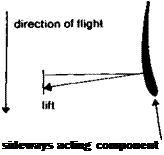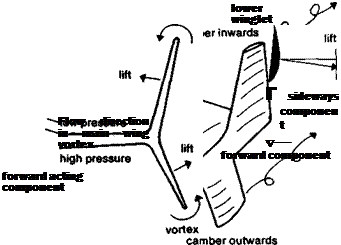WINGLETS
Wing tip plates of the kind just described should be distinguished from winglets and tip sails, which are different in principle. A tip plate or body is intended to restrict or prevent the tip vortex. Winglets and tip sails are designed to use the vortex by extracting some of its energy. This not only weakens the vortex but, if the energy can be turned into a force in the right direction, there is a further small gain. Winglets of the type sketched in Figure 6.8 were first developed by R. T. Whitcomb. As shown in Figure 5.1, the airflow round a wingtip is inclined outwards on the underside, upwards just beyond the tip, and inwards above. The precise angle of the flow to the direction of flight changes as the strength of the vortex varies at different angles of attack and flight speed. If an aircraft such as a commercial jet transport operates most of its time at one steady speed, it is possible to design a set of winglets which project into the vortex flow at such angles that they can, like small wings, extract some ‘lift’ force. If the winglets are set correctly this force will have a forward-acting component which can appear in the general force diagram for the whole aeroplane, as an addition to the thrust. The bulk of the winglet’s lift will, however, be directed laterally and this will not only tend to bend the winglets themselves but will increase the bending loads on the wing main structure. Since the winglets generate lift, each winglet will have a vortex at its end but this will be less intense than the main wing vortex without winglets. Some saving in drag results.
Winglets, as shown in the diagram (Figure 6.8) are cambered and twisted to meet the flow at each point at the most effective angle of attack. They are quite complicated to design and construct and are most efficient over a rather narrow range of flight speeds.


![]()
 |
Fig. 6.8 The Whitcomb winglet











